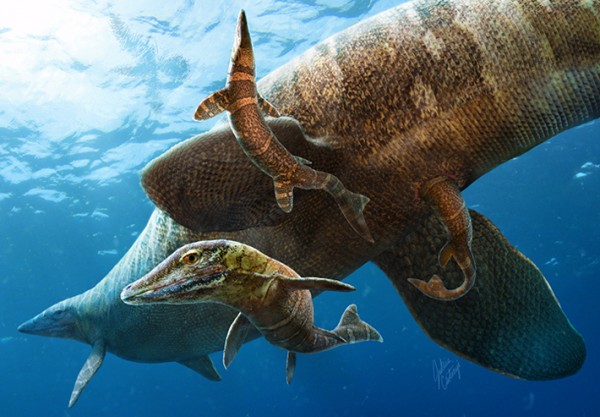Mosasaurs, Marine Giants, Gave Birth in the Ocean Not Near Shore
| Ana Verayo | | Apr 11, 2015 09:59 AM EDT |
(Photo : Julius T. Csotonyi/YaleNews) Mosasaurs gave birth in the ocean and not near shore, according to classic theory.
A prehistoric giant marine lizard that once roamed the Earth's oceans apparently had a unique way of giving birth to its offspring, according to new research.
Researchers from Yale University and the University of Toronto have identified specimens housed at the Yale Peabody Museum of Natural History that make them believe these massive, mighty mosasaurs that grew 50 feet long apparently give birth to their young in the open ocean and not near the shore.
Like Us on Facebook
These new findings now shed light on long held questions about what kind of environment this predator was exposed to during prehistoric times. Mosasaurs ruled the oceans on the planet before they went extinct some 65 million years ago.
According to study lead author Daniel Field from Yale's Department of Geology and Geophysics, mosasaurs were among the most intensively studied vertebrate animals from the Mesozoic era. Evidence about how baby mosasaurs were born and what kind of birthing environment they were exposed to has been historically vague and elusive, however.
Field and his team examined the youngest mosasaurs specimens ever found for this study from fossils discovered more than 100 years ago in Yale Peabody Museum's collections. The fossils were first thought to originate from ancient marine birds.
Field along with Aaron LeBlanc from the University of Toronto concluded the specimens presented different kinds of jaws and teeth features unique to mosasaurs. The fossils were also discovered in open ocean deposits.
LeBlanc confirms the only bird-like features from the fossil specimens were their small size. Theory suggests mosasaurs laid their eggs on beaches and that newborn babies didn't live in sheltered nurseries but this new evidence is contrary to that.
This study was published in the journal, Palaeontology.
TagsMosasaurs: Marine Giants Gave Birth in the Ocean Not Near Shore, mosasaurs, mosasaur babies, mosasaur marine giant lizards, mosasaur gave birth ocean
©2015 Chinatopix All rights reserved. Do not reproduce without permission
EDITOR'S PICKS
-

Did the Trump administration just announce plans for a trade war with ‘hostile’ China and Russia?
-

US Senate passes Taiwan travel bill slammed by China
-

As Yan Sihong’s family grieves, here are other Chinese students who went missing abroad. Some have never been found
-

Beijing blasts Western critics who ‘smear China’ with the term sharp power
-

China Envoy Seeks to Defuse Tensions With U.S. as a Trade War Brews
-

Singapore's Deputy PM Provides Bitcoin Vote of Confidence Amid China's Blanket Bans
-

China warns investors over risks in overseas virtual currency trading
-

Chinese government most trustworthy: survey
-

Kashima Antlers On Course For Back-To-Back Titles
MOST POPULAR
LATEST NEWS
Zhou Yongkang: China's Former Security Chief Sentenced to Life in Prison

China's former Chief of the Ministry of Public Security, Zhou Yongkang, has been given a life sentence after he was found guilty of abusing his office, bribery and deliberately ... Full Article
TRENDING STORY

China Pork Prices Expected to Stabilize As The Supplies Recover

Elephone P9000 Smartphone is now on Sale on Amazon India

There's a Big Chance Cliffhangers Won't Still Be Resolved When Grey's Anatomy Season 13 Returns

Supreme Court Ruled on Samsung vs Apple Dispute for Patent Infringement

Microsoft Surface Pro 5 Rumors and Release Date: What is the Latest?










